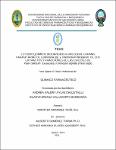Estudio químico biodirigido in vitro sobre formas parasitarias de Leishmania spp. y Plasmodium falciparum de los extractos y fracciones de las especies de Piper callosum (guayusa) y Unonopsis stipitata (vara caspi)

View/
Date
2014Author
Aylas Chujutalli, Andrea Valery
Villacorta Barbarán, Gladys Oriana
Metadata
Show full item recordAbstract
Las enfermedades parasitarias endémicas como la leishmaniosis y la malaria, son responsables de la mayor morbilidad y mortalidad en el ámbito mundial, las plantas medicinales representan una alternativa interesante para el hallazgo de nuevas drogas antiparasitarias. En este estudio se determinó la actividad antiparasitaria in vitro de las fracciones orgánicas y acuosas de las hojas de Piper callosum y Unonopsis stipitata. La fracción orgánica de Éter de Petróleo de Piper callosum, presentó actividad selectiva medianamente activa contra L. braziliensis con un IC50 de 47.18 ug/ml., a diferencia de la fracción orgánica diclorometánica de Unonopsis stipitata que presentó actividad contra las dos cepas de Leishmania: L.amazonensis , y L. braziliensis con un IC50 de 30.8 ug/ml. y 23.8 ug/ml. respectivamente, y que según el rango de la actividad leishmanicida son considerados como activas. De las 5 fracciones orgánicas, la fracción orgánica diclorometánica de Unonopsis stipitata presentó actividad biológica in vitro sobre Plasmodium falciparum FCR3-resistente a cloroquina con un IC50= 9 ug/ml, y un porcentaje de inhibición del 52%. De las dos especies vegetales estudiadas, la fracción orgánica diclorometánica obtenida de la especie Unonopsis stipitata fue la que presento mayor actividad antimalárica y leishmanicida. Endemic parasitie such as the Leishmaniosis and Malaria are the main responsible of the
large number of morbidity and mortality in the world area, medicinal plants represent an
important alternative due to the find of new antiparasitic drugs.
It was determinate of the organics fractions and aqueous of the Piper callosum and
Unonopsis stipitata leaves, the organic fractions of Petroleum Eter of Piper callosum
represented selective activity fairly assets against L. braziliensis with IC50 of 47.18 μg/mL,
different from the dichloromethane organic fraction of Unonopsis stipitata, wich
represented activity against the two stumps of Leishmania: L.amazonensis, and L.
braziliensis with a IC50 of 30.8 μg/mL and 23.8 μg/mL, respectively, and acording to the
range of Leishmania activity are considerated as assets. Among the five organic fractions,
the dichloromethane organic fraction of Unonopsis stipitata represented biological activity
in vitro over Plasmodium falciparum FCR3 – resistent to Cloroquine with IC50 of 9 μg/ml
and a percentage and inhibition of 52%.
Between the two medicinal plants, the dichloromethane organic fraction obtained from the
Unonopsis stipitata specie was the one that represented the major antimalarial and
leishmanicidal activity.
Collections
- Tesis [295]
The following license files are associated with this item:

